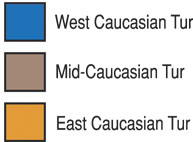 |
 |
Capra caucasica dinniki
Tur occidental (Sp), Westkaukasischer Tur (G), Bouquetin du Caucase occidental (F). Also called Kuban tur.
DESCRIPTION (male) Shoulder height 37-42 inches (95-107 cm). Weight 200-250 pounds (91-113 kg). Females are about 30 percent smaller than males.
Larger than the mid-Caucasian tur, with a more ibexlike appearance. The face is short and blunt. The hoofs are large. The beard is long (up to seven inches, or 178 mm), narrow and prominent. The short summer coat is yellowish-tan, lighter on the back and sides, darker on the head, very dark brown on the tail and lower legs, and dirty white on the belly. The winter coat is heavier and coarser, varying from grayish to yellowish-brown, with a dark dorsal stripe. The horns are black and rather similar to those of an ibex, being scimitar-shaped and having prominent cross ridges on the front surface, but they are much more massive and relatively shorter. The tips are widely separated, the distance varying from about 16-26 inches (41-66 cm), sometimes more. The horns appear almost circular in cross section, actually being triangular with strongly rounded angles and bulging surfaces (especially the orbital and nuchal surfaces; the front surface is flatter). Females have thin, weak horns that are elliptical in section and slightly curved.
HABITAT Open, precipitous terrain at higher elevations, normally above timber line.
DISTRIBUTION A limited range at the extreme northwestern end of the Caucasus Mountains, from Mt. Cugus (northeast of Krasnaya Polyana, which is northeast of Sochi) eastward to include the upper reaches of the Belaya and Laba rivers. Boundaries with the mid-Caucasian tur are unclear.
REMARKS A top game animal that lives in some of the most beautiful mountain country anywhere. The hunt is physically demanding and long shots may be required. Bad weather can be a problem in this region, with fog, rain, hail, snow and strong winds a daily possibility. Hunters should be in shape, go early in the season, and allow enough days. Caucasian chamois, mideastern brown bear, mideastern red deer and the occasional wolf may also be seen, but bear and red deer are not open on early hunts.
|





